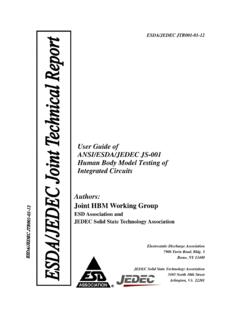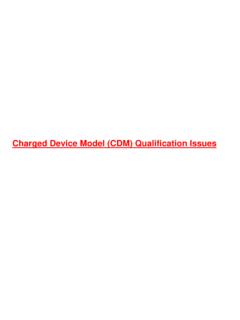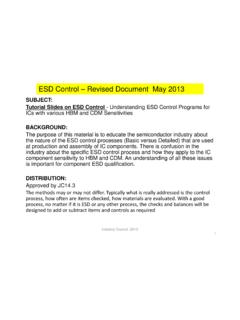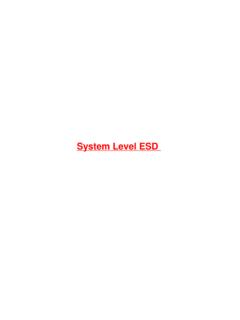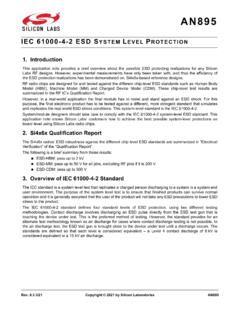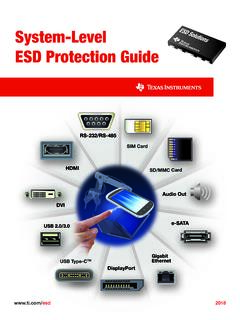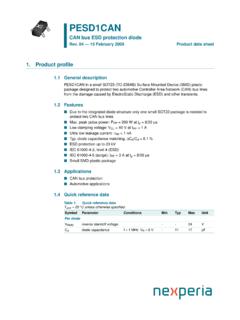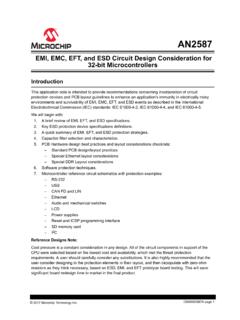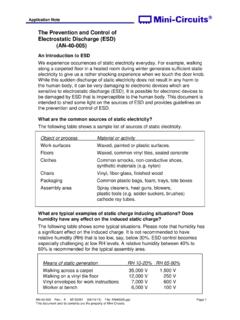Transcription of System Level ESD Expanded - JEDEC
1 System Level ESD Expanded 2 Fred Bahrenburg Dell Tim Cheung - RIM Heiko Dudek Cadence Marcus Dombrowski Volkswagen Johannes Edenhofer Continental / BSH Stephan Frei University of Dortmund (Germany) Masamitsu Honda Impulse Physics Lab Japan Mike Hopkins Hopkins Technical Vsevolod Ivanov Auscom John Kinnear - IBM Frederic Lefon Valeo Christian Lippert Audi Wolfgang Pfaff Bosch Patrice Pelissou EADS Tuomas Reinvuo Nokia Marc Sevoz EADS Pasi Tamminen - Nokia / Technical University of Tempere Matti Uusumaki Nokia / Semtech Wolfgang Wilkening Bosch Rick Wong - Cisco Advisory Board Advisors Industry Council 2012 OEM-Mainframe 20% OEM-Auto 20% University 10% Consultants 15% OEM- Mobile 20% EDA Vendor 15% 3 PREFACE The topic of System Level ESD was addressed by the Industry Council in two parts: Part I: Common Misconceptions and Recommended Basic Approaches Published as JEDEC Document JEP161 Part II: System Level ESD: Implementation of Robust ESD Designs Published as JEDEC Document JEP162 Industry Council 2013 4 Outline What is System Level ESD?
2 Component vs. System Level ESD Misunderstanding about System Level ESD System Efficient ESD Design or SEED Basic SEED Advanced SEED Tools for System ESD Design Advanced Topics Future of System Level ESD 5 Industry Council 2013 Outline What is System Level ESD? Component vs. System Level ESD Misunderstanding about System Level ESD System Efficient ESD Design or SEED Basic SEED Advanced SEED Tools for System ESD Design Advanced Topics Future of System Level ESD 6 Industry Council 2013 What is a System ? IC Component IC Component IC Component System with External IC Pins System with Internal IC Pins A System consists of embedded ICs and other electronic components to form a consumer/automotive/military/medical product that can be exposed to various random uncontrolled severe ESD events with unspecified waveforms Handling under safe ESD control methods only A System can be exposed to all sorts of uncontrolled ESD events 1-1kV 1-35kV Industry Council 2013 7 System Level ESD What is an ESD Event?
3 -Object becomes charged -> discharges to another -Charging levels range from 1 V to 35,000 V Discharge currents range from 1 A to 60 A or more What is a System Level ESD Event? -An electrical System experiences an ESD Event What can happen in a System Level ESD Event? -The System continues to work without problem -The System experiences upset/lockup, but no physical failure. Typically referred to as Soft Failure May or may not require user intervention -The System experiences physical damage Typically referred to as Hard Failure 8 Industry Council 2013 System Level ESD What are some sources of System ESD Events? -Charged Humans -Charged Humans with a Metallic Tool -Charged Cables (Charger, Headset, USB, HDMI,..) -Charged Products themselves -Charged Metal Objects How is the Event Transmitted to the System ? -An Direct contact to a System I/O pin -Direct contact to a System case -An arc through a vent hole or seam to a circuit board -Pickup of EM radiation from indirect ESD -A secondary discharge event within the System 9 Industry Council 2013 System Level ESD Testing System Level ESD (qualification) testing is intended to ensure that finished products can continue normal operation during and after a System Level ESD strike.
4 -The IEC 61000-4-2 ESD Test Method is used to represent one particular scenario of a charged human holding a metal object and discharging to a point on the System -This is the most common test method used to assess the ESD robustness of the System -Other test standards ( , ISO10605 for automotive, DO-160 for avionics) are used; depending on the application System Level ESD Test Results -Pass: System continues to work without interruption -Soft error that corrects on itself -Soft error requiring intervention (reboot, power cycle, ..) -Physical failure 10 Industry Council 2013 Categories of Failures (From Limited Case Studies) Common reported causes of System failure are: -Charged Board Events (CBE) -Cable Discharge Events (CDE) -Electrical Overstress (EOS) -IEC System Level ESD testing (for the soft failures, their relative percentage could be higher) 11 Industry Council 2013 Case Studies of System Level Failures Physical damage was reported more frequently in the 58 case studies tallied by the Industry Council.
5 However, System manufacturers report that physical damage occurred less frequently than soft failure. System manufacturers do not always report soft failures to suppliers. Because most of the case studies were provided by suppliers, data tends to be weighted towards physical damage. 12 Industry Council 2013 Outline What is System Level ESD? Component vs. System Level ESD Misunderstanding about System Level ESD System Efficient ESD Design or SEED Basic SEED Advanced SEED Tools for System ESD Design Advanced Topics Future of System Level ESD 13 Industry Council 2013 System Level ESD vs. Component Level ESD Parameter System Level ESD - IEC Component Level ESD HBM Event example Charged human discharging through a metallic tool to a System Charged human discharging through the skin to a component (IC) model IEC System Level ESD human body model (HBM) Environment End customer s normal operation Factory assembly Standard example Test IEC 61000-4-2 (Powered) ISO 10605 (Unpowered / Powered) JS-001-2013 (Unpowered only) R-C network Peak current A / kV A / kV Typical requirement 8 KV 1 KV (Formerly 2kV) Rise time ~ 1 ns 2 ~ 10 ns Pulse width ~50 ns 150 ns Failures Soft and Hard Hard Application PC, Cell phone, Modem, IC Tester examples KeyTek Minizap, Noiseken ESS2000 KeyTek Zapmaster MK2, Oryx The two tests are distinctly different and serve different purposes Courtesy.
6 Jae Park, TI 14 Industry Council 2013 Waveforms of Component HBM and System Level 4kV-HBM(schematic)4kV-GUN4kV-HBM(schemat ic)4kV-GUN4kV-HBM(schematic)4kV-GUNTime t [ns]Current I [A]Dischargecurrentthrua 2-Ohm load C = 100 pF, R = 1500 Ohm System Level ESD gun test has to be performed under powered conditions For powered systems there are two failure mechanisms -Destructive fail -Functional/Operational fail Improving the component ESD levels will not solve this issue There is no clear correlation of System Level performance to the HBM robustness 4 kV HBM is not the same as 4 kV System Level IEC! Industry Council 2013 15 Note the extreme initial I(peak) due to the direct capacitive coupling with the gun tip 4kV IEC Component Vs. System ESD Comparison HBM Test: closed circuit test where the ESD pulse is applied between 2 or more pins of an unpowered part. CDM Test: static charge is built up on an unpowered part and then discharged from a single pin to a low resistance ground. System Level Test: a device is mounted on circuit board within a user ready and operating System .
7 -Stress is applied between specific locations on the System and the power supply reference ground. -Peak currents, rise time and discharge duration differ from HBM/CDM. Ashton - 2007 16 Industry Council 2013 Component Vs. System ESD Comparison Pass/Fail Criteria -HBM/CDM: based on physical damage - System Level ESD: based on temporary System upset and/or physical damage The discharge paths and the associated currents will be different for these stress methods, therefore NO correlation can be expected Ashton - 2007 17 Industry Council 2013 What is the interacting dependence between component protection and System Level protection? Improving HBM and CDM often makes it harder to Protect the System HBM & CDM circuit design assumes no power to the circuits HBM and CDM do not address soft failures HBM & CDM circuit design assumes no external components On the other hand, System Level ESD robustness is affected by all components and the board design 18 Industry Council 2013 Component Vs.
8 System Test Result Correlation Case studies A through G represent data on products which had failure voltages characterized for both HBM and IEC based System Level test. Data indicates no correlation of HBM failure voltage to IEC failure voltage. This disparity between the two test methods is due to the fundamental differences in the stress waveforms and in the way the stress is applied during the tests 19 Industry Council 2013 Improving the component ESD levels would not improve the System Level ESD performance. Following this, since ICs are now designed for lower component ESD levels, why would this not be reflected by a sudden change in the overall health of a System for its ESD capability? The overall health of a System is dependent on a comprehensive approach to the protection methodology that includes a number of factors including on board protection components, optimized board signal routing, component packaging and, as a last line of defense, the component Level protection.
9 20 Industry Council 2013 Understanding System Level ESD Protection Aren t Integrated Circuits Tested for ESD? Yes, they are tested for HBM & CDM Doesn t that mean they will be fine in a System ? No, they are tested to assure that they can survive manufacturing in an controlled ESD environment But won t that help? No, this is a misconception. Good component ESD does not mean a System is comparably protected. 21 Industry Council 2013 Understanding System Level ESD Protection Outline What is System Level ESD? Component vs. System Level ESD Misunderstanding about System Level ESD System Efficient ESD Design or SEED Basic SEED Advanced SEED Tools for System ESD Design Future of System Level ESD 22 Industry Council 2013 Industry Wide Challenge There is a prevailing misunderstanding between the IC Suppliers and System Level Designers regarding: ESD test specification requirements of System vs. component providers; Understanding of the ESD failure / upset mechanisms and contributions to those mechanisms, from System specific vs.
10 Component specific constraints; Lack of acknowledged responsibility between System designers and component providers regarding proper System Level ESD protection for their respective end products. 23 Industry Council 2013 Why wouldn t you expect to see correlation between device Level and System Level testing? Since the tests are done in different environments (unpowered versus powered or stand-alone versus on board) along with the different stress current wave shapes for the two tests, it is not surprising that they would lack correlation. However when external pins are involved, a higher component Level ESD on these pins could mean less load for the on-board clamp to handle. But this type of approach, while being impractical and unpredictable, also detracts from the need for an efficient System ESD design compatible with the on-board clamp. 24 Industry Council 2013 Industry Wide Challenge Is 2kV "HBM" testing the same as IEC Zap Gun testing? Unfortunately, there is sometimes confusion in the comparison of the two methods.
